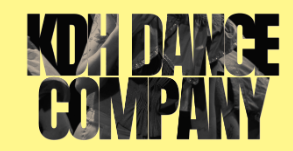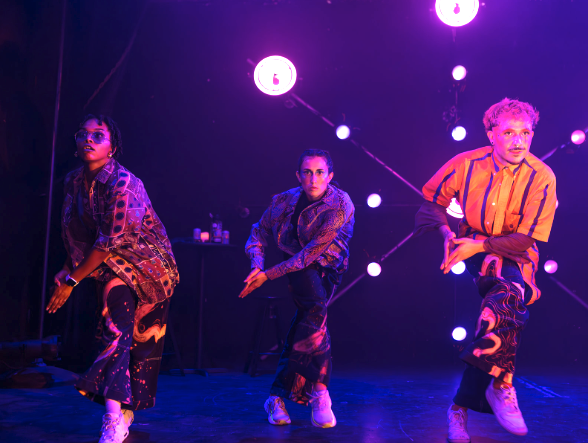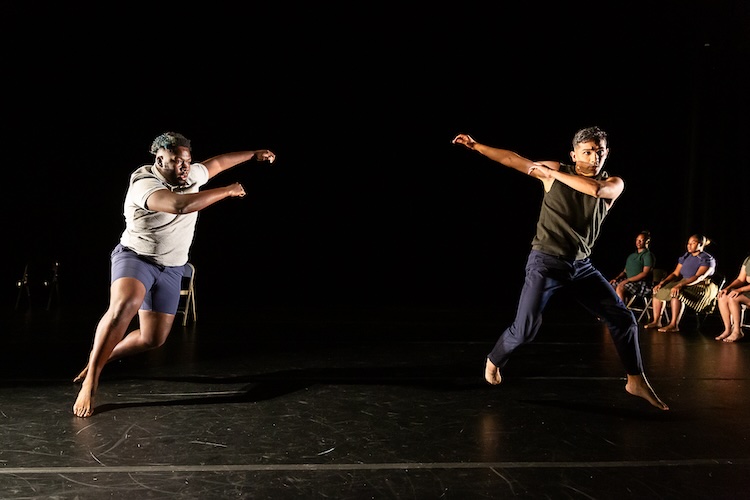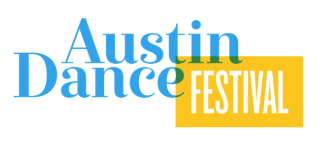Review: Gimpses of the Tenth Austin Dance Festival, Organized by Kathy Dunn Hamrick Dance Company
by David Glen Robinson
Quick looks at sixteen presentations over three days in Austin
“How the West Was,” KDH Dance Company, Austin, TX.
 The title keys our expectations for this company for quirky, absurdist, and athletic performances underlain by deep themes of protection and commitment. Although many in the audience are familiar with the company, now under new leadership (Alyson Dolan, stepping forward for the retiring Kathy Dunn Hamrick, still beautifully present), we weren’t expecting a piece this strong, powering into the future. Part of this was the musical composition by Drew Silverman, now in a permanent position as sound designer for the company. The voiceovers of Clint Eastwood in a spaghetti western in dialogue, building to a shootout, and then fading away (shootus interruptus) as the dancers melted into other shapes and sequences, was high-skill choreography challenging all others. But then, emotional peaks and valleys depicted in movement, spoken word, and music have been a feature of this company for years. The dancers don’t swing from the floor, they swing from their DNA.
The title keys our expectations for this company for quirky, absurdist, and athletic performances underlain by deep themes of protection and commitment. Although many in the audience are familiar with the company, now under new leadership (Alyson Dolan, stepping forward for the retiring Kathy Dunn Hamrick, still beautifully present), we weren’t expecting a piece this strong, powering into the future. Part of this was the musical composition by Drew Silverman, now in a permanent position as sound designer for the company. The voiceovers of Clint Eastwood in a spaghetti western in dialogue, building to a shootout, and then fading away (shootus interruptus) as the dancers melted into other shapes and sequences, was high-skill choreography challenging all others. But then, emotional peaks and valleys depicted in movement, spoken word, and music have been a feature of this company for years. The dancers don’t swing from the floor, they swing from their DNA.
Video - "How the West Was"
“Steady” -- Take Root Dance, Detroit, MI.
The piece was a well-crafted showpiece choreographic technique. It offered three dancers in combinations of trios, duets, and at least one solo by each. The transitions between the sections were smooth and well-rehearsed.
“Fragmented Memories” – Sanchita Sharma, Austin, TX
Sharma, an independent dancer in Austin, Texas, contributed a very bold solo. Every movement and gesture will be scrutinized in any solo piece. Sharma showed great confidence in the perfected execution of even her least movement and gesture, inviting our gaze and taking us into her reverie of movement.
“Phony, Pony, Ho!” – Omnivore Dance, Columbus, OH
The three-word title indicates the three sections of the dance, widely varying in dynamics and emotionality. The first section started with a huge, exaggerated clown face, keying circus tricks by the two dancers. The second was more athletic and acrobatic, down to business. The third was more thoughtful, though faster and more a demonstration of excellence, pleasing the highly appreciative crowd by the end of the piece. It had much choreography in it, creating very clear and distinct sections, assisted by diverse musical pieces in soundtrack.
“Problem Solving” – Social Movement Contemporary Dance Theater, Houston, TX.
This was one powerful piece from an equally powerful company, with choreography shared between two high talents, Elijah Alhadji Gibson and Hutch Hagendorf. The modern choreography was extremely complex. Different sequences of movement seemed woven together or layered and still equally visible, like the crystalline lattices of clay molecules. And like those molecules, the possibilities of “Problem Solving” seem near-infinite. I didn’t want to see it end. Perhaps we will indeed see it again, with another slight twist of the kaleidoscope.
“We Are Many Sea Creatures” – Aryanna Allen and Leo Briggs, Brooklyn NY and Austin, TX.
This was a short duet performed by the choreographers. Much of it was floor work with moderately challenging acrobatic maneuvers. Sequences were enacted, with the chores of gripping, lifting, and turning traded between the performers to create mirror sequences. It seemed to this reviewer that the choreography could have been taken much further, but the end proved to be a crowd pleaser.
“Fish dish snare” – Anna Bauer and collaborators, Austin, TX.
Anna Bauer and her collaborators are members also of the KDH Dance Company, see above. Her group has the look and feel of an adjunct of KDH in which members get to create and perform their own choreography. And that choreography is always sharp and fresh, as Bauer’s piece showed. Yes, about fish, but one of a long line of dance pieces going back to her college days at Sam Houston State University. Her humor is always rich and strictly tongue in cheek, as with the start of this piece, a tableau of dancers lying motionless, at random around the stage like dead fresh-caught fish lying on a dock. The silent audience didn’t know what to make of it. Yet that tableau demarcated every section of the dance, only with the dancers trading positions on stage. In between, there were abstracted movement sequences of the fishing life, some phrases accessible, some opaque, and all punctuated with blackouts. Altogether, the piece was well-rehearsed, well-executed, and full of forward moving potential.
“XS PLS” – Vitality (The Company), Denver, Co.
Humor is a great theme of the festival, and the humor in this piece starts with the title. The hip-hop world has turned bureaucratic acronyms into language, many utterances coded, like WTF is 420? But if you don’t know the codes, you can just make up your own meanings for laughs. The dance piece attached to the title hid mastery and performative excellence behind its jiggly, unserious hip-hop atmosphere. The ensemble of five performing Katie Hazard’s choreography of, danced a beautiful, high-energy blend of hip-hop and contemporary dance, the latter in charge of transitions between duets, trios and other combinations. Of impact equal to the powerful movements by the highly skilled dancers were their perfectly matched costuming and styling, boys and girls in black-on-black fabrics with silver accessories and accents, black socks with matching black sock suspenders (I kid you not), everything tucked in down to the last hair and whisker. The piece showcased the power of hip-hop performed by an athletic ensemble, one with great sensitivity and awareness. They stood in great contrast to some of the other festival groups that showed no regard for the influence of image on choreography. The piece was a peak of the showcases, one of several.
8:00 pm Showcase

“Rhythm and Grooves” (excerpt) -- Ciceley Fullylove, Austin, TX.
The piece was a section out of an ongoing and growing work of rhythm and blues dance, emphasis on rhythm. Four dancers in a lineup across the upstage of the wide Ventures Studio stage began rhythmic moving and phrases to beats laid down in a soundtrack by DJ Tippytoe. The choreography developed complexly, focusing attention on each of the dancers singly and in combination. The performances were highly skilled, and i this reviewer’s opinion peaked with Kelsey Oliver’s trademark floor work. Costumes showed an intense emphasis on color yet were unified by the navy pajama pants with swirling ochre and yellow designs worn by all the performers. Later the reviewer learned in a brief interview that the pants were dyed and bleached to create the designs, an innovation carried out by choreographer Ciceley Fullylove. Thatr element added to a fully developed and very satisfying piece.
“One-sided Conversations” Carissa Topham-Fisher and Emily Rushing, Austin, TX.
The dance was a concept-heavy comic piece. The dancers explored all the many ways communication stops and connection fails—in telephones, texts, e-mails, chit-chat, and other ways. The piece was funny but a little dark-tinged. Telephone and computer aural samples were well edited and integrated with movement cues. Much of the choreography took place on the floor, with dancer connections heavily involved with gymnastics. Costumes were complementary. Slacks and blouses covered by clear plastic rain shells. The bulky look did not, however, impede the dancers’ movements. The skilled piece gave us another floor duet by local dancers.
“Earthbound” – Tsiambwom M. Akuchu, Los Angeles, CA.
And now for something completely different. He goes by Sam. He began his solo piece on center stage, stripped to the waist over loose white drawstring pants, possibly pajama bottoms. His music started and parts of his physique began to move in tempo with the music, starting with his pectorals. He stood in place in the opening sequence, moving his trunk and arms only as a muscle group flexed. He eventually made sweeping movements in the center stage area, but he eventually returned to his starting position. That was the substance of the choreography and dance. Some of the harder flexes were accompanied by frowns and grimaces, as though to highlight the pain of the performance at that point. Those were not good choices. Generations of dancers have moved in the opposite direction. Nureyev and Baryshnikov were giant athletes and artists who worked continually to make their difficult performances look easy, always to create art of transcendence and emotional transport. Sam and his generation can attain such heights only by moving in that same direction.
“Moonfall—the Magician and Muses,” Red Nightfall Dance Theatre, Austin, TX.
The piece was an excerpt from “Moonfall,” a large ballet with original music composition by world-class operatic music composer and UT music professor Sam Lipman. The full-length Moonfall was presented in 2024 at Dada Lab in Austin. The show was a ballet choreographed by equally world class choreographer Dorothy O’Shea Overbey. The excerpt presented in the festival gave us the “Dance of the Magician,” pefomed by prima ballerina Kanami Nakabayashi and her muses. There was no loss of the perfection of performance that Nakabayashi always brings to her work. The piece was the only ballet work in the festival, and it was well appreciated by the audience.
“Stepping Out,” Lydia McDonald and Stephanie Mizrahi, Los Angeles, CA.
The piece was a duet performed by the choreographers. It began slowly but soon proceeded to faster pacing and much floor work with athletic lifts and rolls. Concept for the most part remained obscure after the many other floor-approaching duets earlier. But as in earlier pieces, there was considerable trading of lifts and holds in mirroring phrases. These were highly suggestive of equality in relationships, a significant trend. The costumes did not go far beyond studio wear.
“Onward, to the Side and Around,” Jessica Boone, Bryan, TX.
No doubt about the title of the piece, which is a set of instructions to the dancers. Boone then took the dancers through their paces, showing them exactly what she meant by the instructions at all levels, scales, and dynamics, ending on the floor with dancers twisting their trunks around and walking their fingers to the side and around. Boone, a veteran of the Kathy Dunn Hamrick Dance Company, is currently a professor of dance at Texas A&M University. She brought back her high skills in choreography to the festival.
“3 Duets,” Allysen Hooks Projects, Austin, TX.
Allysen Hooks is a relative newcomer to the Austin dance community. She had the misfortune to be offering three duets to a festival loaded heavily with such, particularly female-female pairings with much floor work. Her duets featured the higher levels, too, with walking and running passages and full occupation of the large space. This expansiveness of vision was refreshing. She is rapidly gaining connections with Austin’s best dancers and dance studios.

“Re:Rosas in Session,” Aimed Dance, Beaumont, TX.
One wonders if there was a typo on the program, but we’re going with it. The company offered a chair dance in the sense that the ensemble of six began the piece seated in chairs onstage, facing the audience. The dance moved back and forth across chairs, moving away from them, back onto them, stepping over them, moving them and sitting down again. Relationships between humans were abstract, and the movements of the chairs did not create a discernible pattern. The sequences of the dance followed the music closely. The choreography ended the piece with dramatic flourishes. Costumes were black-dominant with white and various colored accents creating, altogether, an everyday street look. Styling was neat and contained. The dancers were extremely skilled and provided a very satisfying dance experience.
Finale
The 10th Anniversary ADF had peaks and valleys. They were not related to the skills and talents of the choreographers and dancers.This edition of ADF certainly gave us spectrum of a highly talented dance artists, including the musicians who sent in soundtrack music for the pieces, coordinated by executive director Drew Silverman. Steven Prewitt was the technical and media director. Clearly, the festival is ready to assume national status. Most of the talent, support, and facility is there already (kudos to Ballet Austin).
The festival needs to come unstuck from geography. There seems to be a preference, pehaps a bias, toward groups resident in Austin and probably for insiders in certain circles-within-circles. If the bias and presumptive preferential treatment for nearby neighbors is removed, the festival would offer numerous Austin acts anyway. The city is simply that talented. Preferential treatment encourages a certain casualness that does not continue the push toward excellence. Foe example, assome acts were costumed essentially in studio wear one can see in class all week. The unfortunate contrast with a large company from elsewhere in fashion-designed costumes is a disparity certain to be noted by the audience/community.
Similarly, national acts were styled to preserve the design/choreographic concept and performed neat as a pin. The following act might feature four dancers needing a haircut. We are decades beyond Twyla Tharp sending her company to Vidal Sassoon’s salon for the same sharp hair style. (Twyla, come back!) It’s time to stop hiding sloppiness behind keep Austin weird slogans.
Reorganization of the selection process might help. Companies submit videos with their applications to appear at the festival. Are they required to perform the piece shown in the video? Informally organized groups with only two names on the masthead might need more organization before they qualify in a material way for ADF. The first rung on the ladder needs to be set higher. And if an application contains the words “improvised” or “improvisational,” the response should be “Wonderful. Let us see your piece when it is fully developed.”
It may be that the lack of such requirements affecte ADF Year 10. To wit: there were quite a few dances, passages, and sequences that can be readily characterized as “two-girls-rolling-on-each-other.” It seems to be a new, somewhat shallow, motif. It was surprising how multiple companies in diverse, widespread locales had the telepathy to come up with that motif.
The selection committee could program offerings of such dances to avoid immediate repetition by more intense scrutiny of the offerings.
And back to styling: choreographers and producers failed to exert the control to tell dancers at auditions to “cut that hair!” That weakness gave us bushy, bushy hair down in the face early in pieces, and, later in the same piece, sweaty, scraggly, ragged, tentacular, Medusa hair that created the Bride of Frankenstein fright wig look. There were several cases of that in the showcases, none likely to have been intentional, though anything is possible. Losing or distorting the image of the performer’s face sends a negative message today with our issues of identity and victimhood (serious note to choreographers—do you realize you are sending that message? Yes or no—and make it an intentional choice!).
We look forward to next year’s edition of the Austin Dance Festival. The enthusiasm of the stage performers and the audience may energize many creative efforts for a year until then.
Tenth Austin Dance Festival, 2025
by various
Kathy Dunn Hamrick Dance Company
April 03 - April 05, 2025
somewhere in Austin
to be announced
Austin, TX, 78700
April 3 - 5, 2025
Austin, Texas
